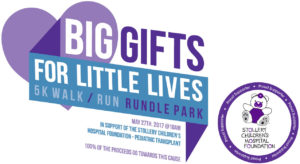
Hi Everyone!
My name is Albert Chan. I am a Physiotherapist, a Runner and a Clinic Owner of Elevation Physiotherapy. Matt Norminton kindly lets me run with his group, the Running Room Athletic Club, which is how I learned about the Big Gifts for Little Lives Race. As you know, this is a fundraiser for the Stollery Children’s Hospital. As well as learning about George Kemp’s medical needs, we knew we wanted to be involved with this race as participants as well as a corporate sponsor. So, thank you Jen and Matt Norminton and Lindsey Kemp for this wonderful opportunity.
Whether you plan on walking or running the race, it will be an early season event for many participants, which means we have 6 weeks to prepare for an event which we may not be physically prepared for after a long winter. As such, I will be posting 6 weekly blog posts as a countdown to the event, each with interesting tips and suggestions on how to prepare for this event and to complete it well.
In this first article, I will answer an often asked question, “What are the benefits of foam rolling?”
Whether you go old school with a PVC pipe, or a typical high density foam roller or those with bumps or the handheld versions with rolling stainless steel balls, the benefits and effects are similar. Perhaps choose one that travels well so that you can pack it into your suitcase as a must-have pre- and post-race tool. Also, there has been no studies on the added benefits of balls or rollers that vibrate and so, unfortunately, there is no current answer as to whether these expensive rollers are worth the cost.
The following are the benefits of foam rolling before a race. Foam rolling:
1. Increases joint range of motion.
2. Increases blood flow to local muscles/fascial tissue.
3. Increases one’s pressure pain threshold and so it reduces one’s perception of pain in the muscles that are rolled.
4. Reduces the resistance of fascial tissue and muscle, which better prepares it for exercise.
5. Does not reduce a muscle’s strength pre-race and so there is no negative effect on performance.
Current recommendations are that we limit foam rolling of muscles between 60-90 seconds depending on the size of the muscle before an activity. Beyond this, there appears to be a risk in reducing muscle strength and performance. Foam rolling should never substitute for a proper warm-up that includes light cardiovascular activity and dynamic movements.
The following are the benefits of foam rolling post-exercise, especially high intensity exercise like a 5km race.
1. The increase in pain pressure threshold reduces one’s perception of pain in the muscle rolled.
2. There is a reduction in delayed onset of muscle soreness that follows high intensity exercise if one continues to roll in the days following the activity.
3. There is a reduction in the resistance between muscle and fascial tissue, thus reducing the inevitable loss of range of motion that ensues vigorous exercise.
Most rolling duration guidelines are developed to prevent performance loss during pre-race or during an activity and so there are fewer guidelines for rolling duration post activity. Since most of us experience some form of muscle discomfort after vigorous activity, my personal recommendation is to roll enough to reduce the feeling of pain or stiffness in the area but not so much that the rolling itself now worsens your pain. Unlike pre-race where the entire length or breadth of the muscle should be rolled to prepare it for activity, in post race rolling, focus instead on those areas that are particularly stiff or painful to aid in its recovery. In other words, just remember the reason for why you are rolling. In pre-race, it’s all about “waking up the muscle.” Post-race is all about recovery, pain reduction and relaxation. There is no time restriction on rolling post race.
Should rolling be done regularly apart from race days? Absolutely! Given the positive effects described above, every athlete should be a competent and efficient roller. Although there is currently no studies on the long term effects of rolling, the benefits of rolling need not be limited to exercise days only. In fact, since rolling over fascial tissue like the iliotibial band (IT band) tends to be quite uncomfortable if not downright painful for some, the more frequently you roll this tissue, the less painful it will become. Think of it as daily increasing your pressure pain threshold!
Come race day, be sure to come by the Elevation Physiotherapy tent prior to the race and have your muscles rolled by our physiotherapists as part of your warm-up! And then after your race, feel free to stop by again to have your muscles rolled as part of your cool down and recovery. Or if you like bring your own foam roller or hand held rolling device and one of us can lead in a group roll!
Submitted by Albert and Karen Chan
